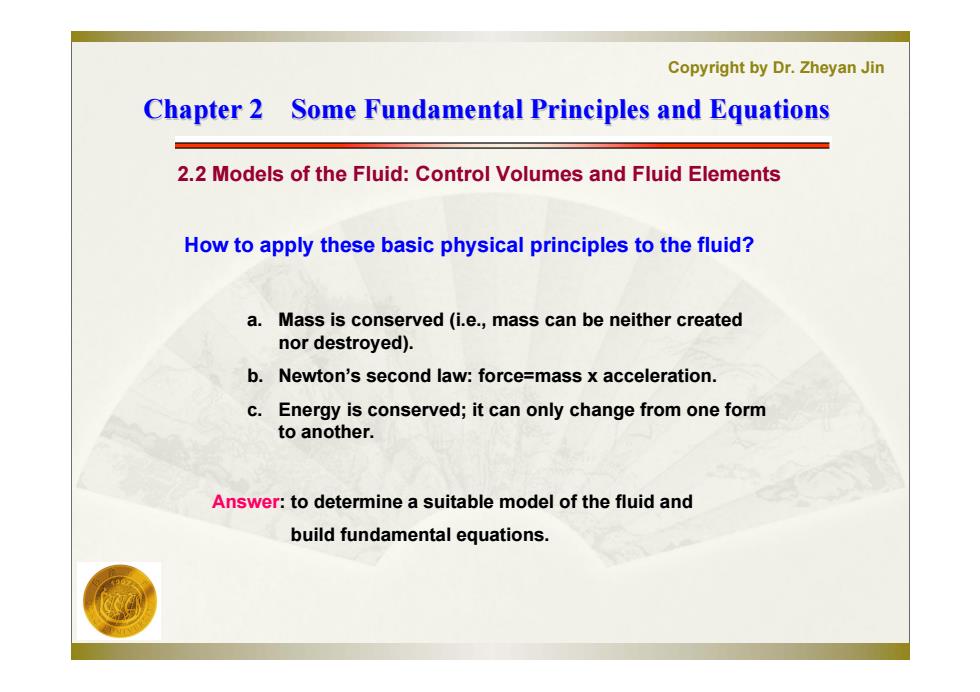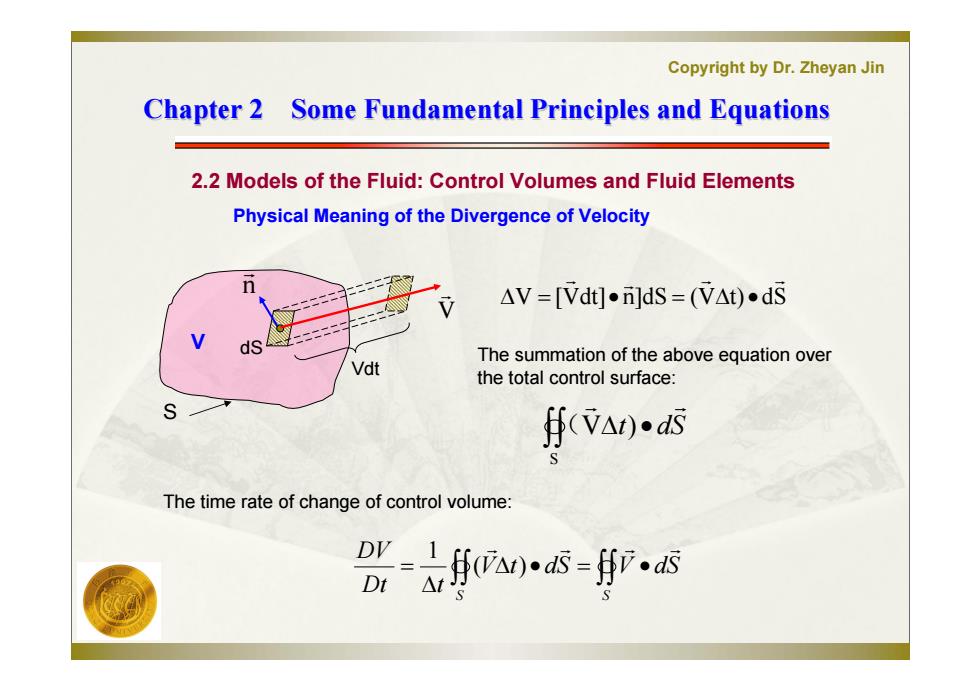
Copyright by Dr.Zheyan Jin Chapter 2 Some Fundamental Principles and Equations 2.1 Review of Vector Relations Relations Between Line,Surface,and Volume Integrals Stokes'theorem: fAds-∬xAas Divergence theorem: 时A.as=∯0aV Gradient theorem: fps-用paV
Copyright by Dr. Zheyan Jin Chapter 2 Some Fundamental Principles and Equations Chapter 2 Some Fundamental Principles and Equations 2.1 Review of Vector Relations Relations Between Line, Surface, and Volume Integrals Stokes’ theorem: S V pdS pdV C S A d A dS s ( ) A dS A dV S V ( ) Gradient theorem: Divergence theorem:

Copyright by Dr.Zheyan Jin Chapter 2 Some Fundamental Principles and Equations 2.2 Models of the Fluid:Control Volumes and Fluid Elements How to apply these basic physical principles to the fluid? a.Mass is conserved(i.e.,mass can be neither created nor destroyed). b.Newton's second law:force=mass x acceleration. c.Energy is conserved;it can only change from one form to another. Answer:to determine a suitable model of the fluid and build fundamental equations
Copyright by Dr. Zheyan Jin Chapter 2 Some Fundamental Principles and Equations Chapter 2 Some Fundamental Principles and Equations 2.2 Models of the Fluid: Control Volumes and Fluid Elements a. Mass is conserved (i.e., mass can be neither created nor destroyed). b. Newton’s second law: force=mass x acceleration. c. Energy is conserved; it can only change from one form to another. How to apply these basic physical principles to the fluid? Answer: to determine a suitable model of the fluid and build fundamental equations

Copyright by Dr.Zheyan Jin Chapter 2 Some Fundamental Principles and Equations 2.2 Models of the Fluid:Control Volumes and Fluid Elements Control surface S S Control Volume V Finite control volume moving with the Finite control volume fixed in space fluid such that the same fluid particles with the fluid moving through it are always in the same control volume The control volume is reasonably large,finite region of the flow
Copyright by Dr. Zheyan Jin Chapter 2 Some Fundamental Principles and Equations Chapter 2 Some Fundamental Principles and Equations 2.2 Models of the Fluid: Control Volumes and Fluid Elements Finite control volume fixed in space with the fluid moving through it Control surface S The control volume is reasonably large, finite region of the flow. V S Control Volume V Finite control volume moving with the fluid such that the same fluid particles are always in the same control volume

Copyright by Dr.Zheyan Jin Chapter 2 Some Fundamental Principles and Equations 2.2 Models of the Fluid:Control Volumes and Fluid Elements Infinitesimal fluid element moving along Infinitesimal fluid element fixed in a streamline with the velocity V equal space with the fluid moving through it to the local flow velocity at each point The fluid element is infinitesimal in the same sense as differential calculus;however,it is large enough to contain a huge number of molecules so that it can be viewed as a continuous medium
Copyright by Dr. Zheyan Jin Chapter 2 Some Fundamental Principles and Equations Chapter 2 Some Fundamental Principles and Equations 2.2 Models of the Fluid: Control Volumes and Fluid Elements Infinitesimal fluid element fixed in space with the fluid moving through it The fluid element is infinitesimal in the same sense as differential calculus; however, it is large enough to contain a huge number of molecules so that it can be viewed as a continuous medium. dV Infinitesimal fluid element moving along a streamline with the velocity V equal to the local flow velocity at each point dV V

Copyright by Dr.Zheyan Jin Chapter 2 Some Fundamental Principles and Equations 2.2 Models of the Fluid:Control Volumes and Fluid Elements Physical Meaning of the Divergence of Velocity n △V=[Vdt]n]dS=(VAt)●ds The summation of the above equation over Vdt the total control surface: (VA)ds The time rate of change of control volume: 兴-w5-s
Copyright by Dr. Zheyan Jin Chapter 2 Some Fundamental Principles and Equations Chapter 2 Some Fundamental Principles and Equations 2.2 Models of the Fluid: Control Volumes and Fluid Elements Physical Meaning of the Divergence of Velocity The summation of the above equation over the total control surface: S V t) dS ( V [Vdt] n]dS (V t) dS S S V t dS V dS Dt t DV ( ) 1 V S n Vdt dS The time rate of change of control volume: V